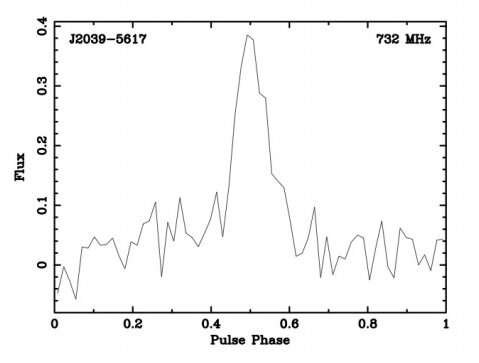August 5, 2020 report
Radio pulsations detected from the gamma-ray millisecond pulsar PSR J2039−5617

Using the Parkes telescope, an international team of astronomers has performed a monitoring campaign of a gamma-ray millisecond pulsar (MSP) known as PSR J2039−5617. The observations detected radio pulsations from this source, which sheds light on the nature of this object. The finding is reported in a paper published July 29 on arXiv.org.
Pulsars are highly magnetized rotating neutron stars emitting beams of electromagnetic radiation. The most rapidly rotating pulsars, with rotation periods below 30 milliseconds, are known as millisecond pulsars. It is assumed that MSPs are formed in binary systems when the initially more massive component turns into a neutron star that is then spun-up due to accretion of matter from the secondary star.
Spider pulsars are a class of extreme binary pulsars with semi-degenerate companion stars. These objects are further categorized as "black widows" if the companion has extremely low mass (less than 0.1 solar masses), while if the secondary star is heavier, they are called "redbacks."
When it comes to gamma-ray pulsars, they are rotating neutron stars emitting gamma-ray photons. Some of them also showcase radio emission that is often difficult to detect. This is most probably due to the fact that their narrow radio beams miss the sightline toward Earth.
4FGL J2039.5−5617 is a gamma-ray source identified by NASA's Fermi spacecraft. Recently, gamma-ray pulsations were detected from this source at a period of 2.6 milliseconds; hence, it was classified as a gamma-ray MSP and received designation PSR J2039−5617.
Now, a group of astronomers led by Alessandro Corongiu of the Cagliari Observatory, Italy, report the detection of radio pulsations from this source.
"Here, we report on the first detection of radio pulsations from 4FGL J2039.5−5617 using more recent observations that we obtained with the Parkes radio telescope in 2016, before the source had been identified as a gamma-ray MSP," the researchers wrote in the paper.
The radio pulsations of PSR J2039−5617 were identified at 0.7, 1.4 and 3.1 GHz, at the 2.6-millisecond period. In all of these three bands, the radio signal was found to consist of a broad single peak.
At 1.4 GHz, the observations revealed clear evidence of eclipses of the radio signal for about 50 percent of the orbit at pulsar superior conjunction. The astronomers noted that such behavior is characteristic for redbacks, and could be associated with a cold or a hot intra-binary gas.
Furthermore, the dispersion measure of PSR J2039−5617 was measured to be 24.57 pc/cm3, which indicates that the pulsar is located some 2,900 or 5,500 light years away, depending on the assumed galactic electron density model. The mass of PSR J2039−5617 is estimated to be between 1.3 and 1.6 solar masses.
In concluding remarks, the authors of the paper said that further observations of PSR J2039−5617 should be focused on searching for X-ray pulsations from this source.
More information: Radio pulsations from the γ-ray millisecond pulsar PSR J2039-5617, arXiv:2007.14889 [astro-ph.HE] arxiv.org/abs/2007.14889
© 2020 Science X Network




















